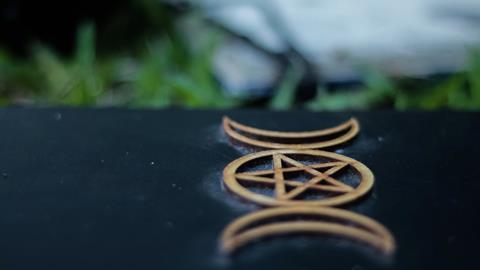Apologist Joel Furches explores the central beliefs of Wicca and looks at its historical relationship with Christianity
From the Atlantic, to NBC, to Newsweek, the news is in: witchcraft and its religious face, Wicca, is experiencing a dramatic revival across the United States. But what exactly is Wicca?
Practitioners of Wicca claim that it is a return to the pre-Christian pagan practices hailing back to the roots of civilization. In fact, it seems to draw clout from the fact that it represents the most ancient means by which human beings understood their relationship with nature and the religious practices they performed under those assumptions.
Nevertheless, there is no uniting text or oral history from which Wiccan beliefs or practices are drawn. There is no Wiccan “orthodoxy”. As a religion it tends to be atomistic and driven almost entirely by personal intuition. But this does not mean there is no history behind it or that there aren’t common practices, beliefs or understandings represented among practitioners.
Read more:
Was Halloween originally a Christian festival?
Halloween: scary movies, religious belief and wish fulfilment
I became a Christian through a pumpkin party
The history of Wicca
While various practitioners will claim that the history of Wicca goes back as far as civilization itself, the modern incarnation of Wicca – which includes the name, terminology, symbolism and general understanding of history – can be traced through a line of 20th Century individuals who collectively contributed to its understanding.
Gerald Gardner is largely considered to be the founder of Wicca, or as he called it “wica” (the extra ‘c’ was added sometime in the 1980s). According to Gardener, “wica” was derived from Scots-English, and meant “wise people”.
Gardener was a folklorist and world traveller who became involved in a coven of witches in Highcliffe, England in the 1930s. Having been initiated, Gardener eventually purchased land in the village of Brickett Wood, opened a centre for folkloric studies and established his own coven to practise in the area. It was during this time that Gardener met the famous occultist Aleister Crowley. Gardener and Crowley were fast friends, and it was Crowley who allegedly put the idea in Gardener’s head to begin a new religion founded around the ancient pagan practices of European lore.
At his centre for folkloric studies, Gardener amassed an impressive collection of occult objects, which was eventually sold off to Ripley’s Believe it or Not after his death.
Before he died, Gardener published his signature work, Witchcraft Today, in which he defined the modern practice of witchcraft and coined the term “wica”.
While Gardener’s book may have initiated the modern practice of witchcraft, the work of a previous author, Margaret Murray, certainly contributed to it. In her 1921 book, The Witch Cult in Western Europe, Murray, who was herself a folklorist as well as a feminist and Egyptologist, documented practices of witches that were later adopted by Wicca. The scholarship in Murray’s book was questionable, but it is nevertheless required reading in Wiccan Covens.
One of the important ideas contributed by Murray was the idea of the goddess – the female spirit of nature, which is fundamental to most understandings of Wiccan belief and practice. This is one of the things that sets Wicca in contradistinction to most mainline religions. Christianity, Judaism, Islam, and Buddhism are all said to have male founders, with the first three typically understanding God in masculine rather than feminine terms.
With Murray being a feminist, Wicca has subsequently gained traction within feminist circles due to its heavy emphasis on the feminine within its understanding of spirituality. Witches are understood to be “wise women”, with Murray’s tradition suggesting that within pre-Christian Europe, the village witch was sought out for healing, advice and general consultation in matters requiring wisdom. It was Christianity, Murray claims, that began to cast witches in a sinister light.
Wicca made its way to America in the 1960s when a British expatriate with ties to Gardener founded his own coven in Long Island. The practice was brought to the West Coast by another British immigrant who had moved her way through several covens in England before moving to Los Angeles. This individual, Sybil Leek, worked Astrology into the practice, and the two practices seemed to fit hand-in-glove.
Wicca gained status in American pop-culture in the 1970s when a practitioner published a successful autobiography. Following the success of his book, this Wiccan, Alex Sanders, released a film, Legend of the Witches, which cemented Wicca as an alternative lifestyle for American youth.
Wicca gained entry into the academy around this same time as professor-practitioner, Laurie Cabot, began to teach college courses on the subject, and gained some celebrity of her own by helping police to solve cases by use of witchcraft.
Wicca was finally recognised as a protected religion within America in 1986, and has gone on to win several civil trials permitting practitioners freedom to bring ritualistic objects and ideas into public life.
Get access to exclusive bonus content & updates: register & sign up to the Premier Unbelievable? newsletter!
Sources for Wiccan beliefs and practices
There is no orthodoxy or officially recognised method by which Wicca is to be practised, but this does not mean there are no sources upon which Wiccans informally agree. Several of those were covered in the previous section on the history of the practice, however the most notable source of Wiccan beliefs is titled Book of Shadows and was written by the founder of Wicca, Gerald Gardener.
Shadows is a book of spells and rituals which gives Wicca its teeth. One of the earliest practices adopted by Wiccan covens was for each initiate to transcribe the Book of Shadows by hand. While originally written in the 1940s, Shadows was revised for publication by journalist Doreen Valiente. One of Valiente’s major contributions to Shadows was a careful removal of the influence of Aleister Crowley, whose dabbling in the occult had been extreme, even by Wiccan standards.
Prior to writing Shadows, Gardener had published a fantasy novel titled High Magic’s Aid, which itself contained descriptions of practices and spells. Despite being a work of fiction, Wiccans still consult this fantasy novel as a source for some of their practices and beliefs.
Wiccan holidays
Any description of Wiccan practices has to come with the caveat that there are no absolute standards within the system, and that each individual practices the religion as they see fit.
That said, there are a few commonalities which can be found in most Wiccan communities. Especially prominent is the observance of certain holidays. Wiccans base their holidays around the movement of celestial bodies, most prominently the sun and the moon. As the Earth revolves around the sun, Wiccans describe this passage as the “Wheel of the Year”, with each celebration considered a participation in the “Turning of the Wheel”.
Wiccan holidays are called “Sabbats”, a word borrowed from the Hebrew word meaning “Sabbath”, with half of the celebrations focusing on the moon and the other half on the sun. Full moons and dark moons are the pinnacle of the moon holidays, with the two solstices being the pinnacle of the sun holidays.
Other holidays involve the changing of the seasons. Holidays are celebrated by decorating altars with seasonal plants and herbs, by lighting candles and by spell-casting.
Wiccan magic
Spell-casting and magic in Wicca is largely reliant on hearsay and intuition, but there are two general underlying principles at play. The first of these assumes that one can “manifest” an item or event by intense mental focus. This assumes that perception shapes reality, and that if one believes in something hard enough, that thing will happen. This process may be aided by props such as crystals and candles, but it is nevertheless the idea that one’s intent makes things occur.
The second general principle is that of “sympathy”. This principle suggests that one can guide something to happen by modelling it on a small scale. The most well-known example of sympathetic magic is the “voodoo doll”, wherein manipulating a doll associated with a specific person will also manipulate that person. While voodoo dolls are not necessarily involved in Wiccan practices, they nevertheless demonstrate how modelling an event is believed to bring that event about “sympathetically”.
Wiccan beliefs
One must paint Wiccan beliefs with broad strokes, given the lack of unifying principles in the religion, but there are some shared principles which may be attributed to the practice.
One of these beliefs is that nature is fundamental, and Wiccan practice is frequently cast as the worship of nature. Wicca is friendly to pantheism, which suggests that nature itself is divine. Among the divine aspects of nature is the god and goddess, a male and female aspect of nature which each have their own specific attributes, but combine to make the Universe function.
Belief in things like astrology, reincarnation, crystal healing and other ideas associated with the New Age movement are not uncommon within Wicca
Wicca and Christianity
Wicca is a surprisingly malleable religion, and is practised equally by pantheists, atheists and people with no particular religious stance. Perhaps it is the ambiguity with which the beliefs are held that allows it to be so versatile.
From a Wiccan standpoint, Christianity is fairly distasteful given that it is credited with the elimination and suppression of the beliefs and practices to which they ascribe. However, in principle, there is no reason a Wiccan would absolutely forbid a person from practising while remaining Christian.
From a Christian standpoint, Wicca is tremendously incompatible with Christian belief and practice. The very first commandment within the ten commandments is “You shall have no other gods before me”, followed by the commandment to not make “graven images” and worship them.
In Christianity, God is transcendent from nature, and any form of nature worship is idolatry, specifically, worshipping that which is not divine. The beauty and perfection of nature, both in biology and in the cosmic realm are considered to be a testament to a remarkable Creator, and to marvel at nature is to worship its Creator-God (Psalm 19).
Wicca is not entirely wrong about the relationship between Christianity and Witchcraft. While the Church’s history of witch trials is nothing to be proud of, the principle that trying to practise some kind of magic is incompatible with the Christian idea that all power and authority belongs to God is nevertheless very true.
Witch hunts in the Bible
The only significant instance of witchcraft in the Old Testament relates directly to King Saul. Saul was not known for his strict adherence to the Mosaic Law – violating it more than upholding it – but he was suspiciously zealous in his pursuit and execution of witches. The books of Samuel do not give much detail, but it’s easy to imagine why a reputedly paranoid and neurotic king like Saul would be interested in finding and killing witches.
After the reign of Saul, one does not see much reference to witches in the remainder of the Old Testament, and the New Testament approach to witchcraft takes a surprising turn. We see two specific instances of witchcraft in the New Testament, both in the book of Acts. In the first of these, a demon-possessed girl who was being used by a local occultist for fortune-telling is exercised by Paul, and is converted as a result. Later in the book, a sorcerer by the name of Simon grows jealous of the miraculous acts of Peter and tries to purchase some of that power. After interacting with Peter, he eventually renounces his cultic practices and becomes a Christian.
In the New Testament witches aren’t hunted or persecuted, they are converted.
Christians and witches
The appeal of the occult is the draw of the unknown. The very ambiguity of Wicca makes it appealing, as one is able to explore the unknown and uncover that which seems mysterious.
The appeal of Christianity is the opposite: instead of the darkness of the unknown, it offers the light of knowing God and being known by God.
Despite the sinister light into which witchcraft has been cast within Christian tradition, I suggest we take the approach of Peter and Paul in relation to witchcraft: not condemnation but evangelism.
Joel Furches is an apologist, journalist and researcher on conversion and deconversion, based in the USA.























